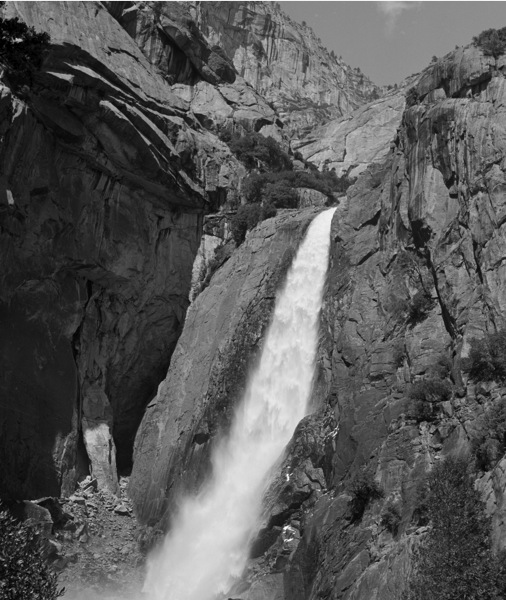They (Don’t) Turn It Off at Night
Lower Yosemite Falls was yet another experience of wonder during my first trip to Yosemite. Due to my fear of getting equipment wet, this image reflects the last distance I deemed safe for my camera as I hiked closer and closer. After covering my vulnerabilities, I proceeded along a short mist trail to the base of the falls. Probably because of the emotion of the experience, I remember that hike very well.
The ever-present background hiss of the pounding water gains decibels and texture with each step forward. After a few minutes on the trail, the falls are hidden, but there remain many non-visual clues telling you that you are gaining on your objective. With a slight breeze, you are gradually covered with a refreshing spray, and sunglasses soon cross the line from asset to liability as the coating of water droplets unjustifiably obscures the rich and lustrous visual details of the scenery. At last, the falls re-emerge and fill much of your field of vision (and, verify, your experience) as you arrive at a bridge spanning the stream which drains the fallen water. The bridge is wet and a little slippery in places. Keeping your eyes open requires mind-over-matter effort; cool water spraying directly into your eyes is enough to trigger more than a mild reflex from your eyelids. To proceed on the bridge, you look away from the falls so that you can keep your eyes open long enough to see where you are going. Standing on the bridge, you at last turn to face the overwhelming falls. As you face forward, blinking in a strobe-like fashion, you behold the base of the water falls, where the sound has matured to thunder-like volumes and quality. With hands firmly on the wet and cold handrails, you feel the bridge resonating with the low-frequency components of that thunder. Within moments you realize, for perhaps the first time in your teenage years, that there are occasions when style should yield to the practicality of function — that geeky-looking raincoat just might have been a good idea after all. The combination of over-watered eyes, soaking wet clothes, and a convecting wind accelerates your departure from the bridge. The time you stood there and faced the glory of the falls was a brief but intense multi-sensory encounter that demonstrably and unequivocally measured how your physical power ranks against that of a force of nature.
Smitten by my first experience, I resolved to return to this location many times. On one of those return trips, I was with my family and we were lodged close to these falls. One evening after dark, while the rest of my family stayed in the room, I stepped out for a few minutes. Upon my return, I reported on my little adventure and casually announced that they had turned off the falls for the night (as if they only turn them on for the tourists). My young children, not yet fully adjusted to my sense of humor (which does take many years), took my words at face value and thought it was quite remarkable that they would do that. As they thought about it a little more, it didn’t take much time for them to realize that, in fact, we don’t have the on/off switch and thus the falls really are on all night long, too.
By itself, Lower Yosemite Falls is an impressive site — particularly in the spring time, when the water flow reaches its zenith. However, at 97m in height, this is only the last (and shortest) of three stages of Yosemite Falls which has a combined height of 739m. Indeed, this lower portion is only the tail of the falls.
This image, flawed as it is, was scanned from a 27-year-old medium-format negative which was created at the same time (and with the same camera) as the image in last week’s posting describing my first trip to Yosemite.

Photo of the Week
2007.05.07

